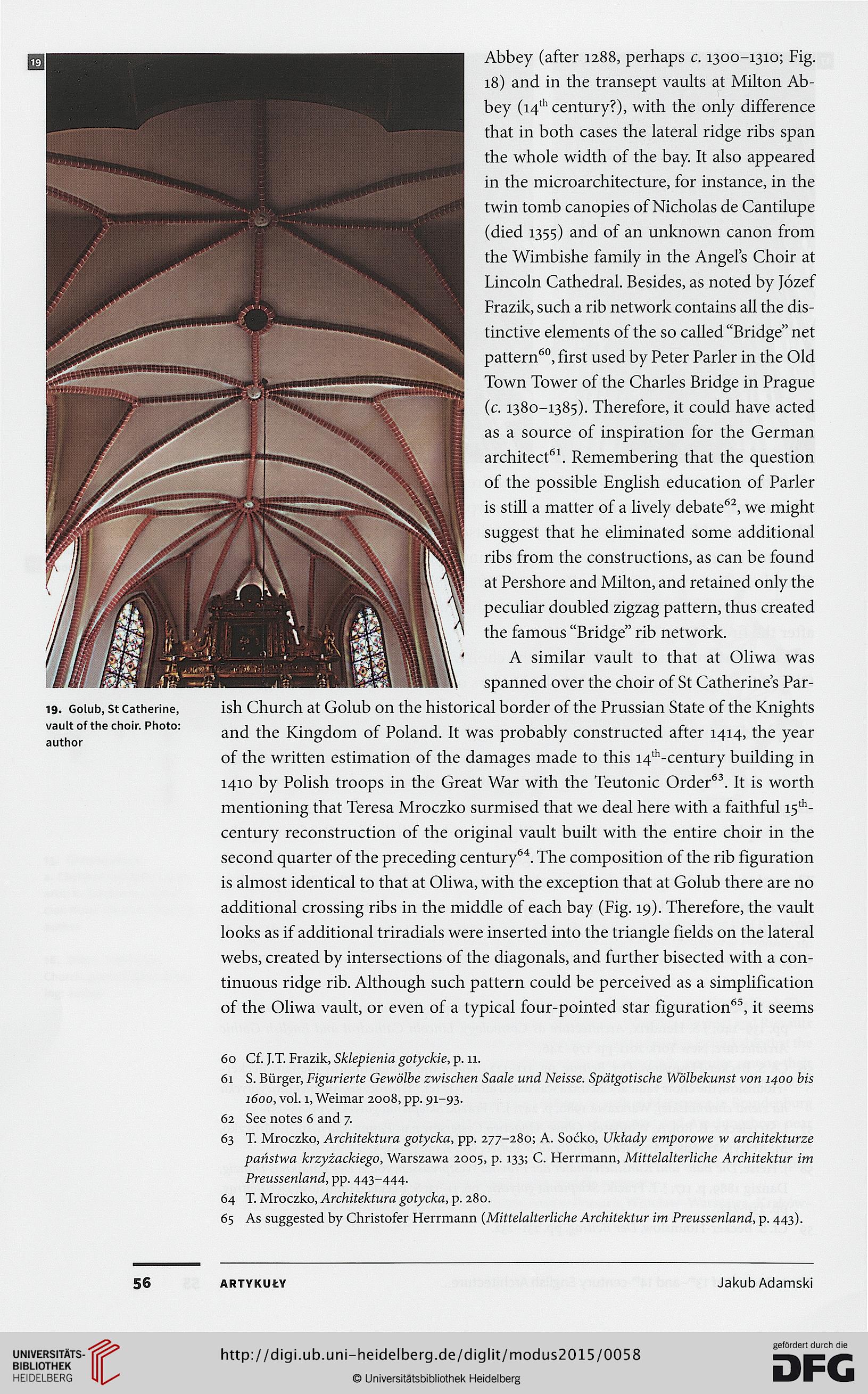E
19. Gotub, St Catherine,
vautt of the choir. Photo:
author
Abbey (after 1288, perhaps c. 1300-1310; Fig.
18) and in the transept vaults at Milton Ab-
bey (14^ century?), with the only difference
that in both cases the lateral ridge ribs span
the whole width of the bay. It also appeared
in the microarchitecture, for instance, in the
twin tomb canopies of Nicholas de Cantilupe
(died 1355) and of an unknown canon from
the Wimbishe family in the Angels Choir at
Lincoln Cathedral. Besides, as noted by Józef
Frazik, such a rib network contains all the dis-
tinctive elements of the so called "Bridge" net
pattern*^, first used by Peter Parler in the Old
Town Tower of the Charles Bridge in Prague
(c. 1380-1385). Therefore, it could have acted
as a source of inspiration for the German
architect*^. Remembering that the question
of the possible English education of Parler
is still a matter of a lively debate*^, we might
suggest that he eliminated some additional
ribs from the constructions, as can be found
at Pershore and Milton, and retained only the
peculiar doubled zigzag pattern, thus created
the famous "Bridge" rib network.
A similar vault to that at Oliwa was
spanned over the choir of St Catherines Par-
ish Church at Golub on the historical border of the Prussian State of the Knights
and the Kingdom of Poland. It was probably constructed after 1414, the year
of the written estimation of the damages made to this 14^-century building in
1410 by Polish troops in the Great War with the Teutonic OrdeGL It is worth
mentioning that Teresa Mroczko surmised that we deal here with a faithful 15*-
century reconstruction of the original vault built with the entire choir in the
second quarter of the preceding centuryW The composition of the rib figuration
is almost identical to that at Oliwa, with the exception that at Golub there are no
additional crossing ribs in the middle of each bay (Fig. 19). Therefore, the vault
looks as if additional triradials were inserted into the triangle fields on the lateral
webs, created by intersections of the diagonals, and further bisected with a con-
tinuous ridge rib. Although such pattern could be perceived as a simplification
of the Oliwa vault, or even of a typical four-pointed star figuration*^, it seems
60 Cf. J.T. Frazik, Sklepienia gotyckie, p. 11.
61 S. Burger, Fignrierte Gewoike zwiscken Sooie ond Neisse. Spdtgotiscke Woikekonst von 1400 kis
1600, vol. 1, Weimar 2008, pp. 91-93.
62 See notes 6 and 7.
63 T. Mroczko, Areki teki ora gotycko, pp. 277-280; A. Soćko, Gkindy emporowe w orek;'tekturze
państwo krzyżackiego, Warszawa 2005, p. 133; C. Herrmann, Aiitteiaiterk'cke Arckitektur ini
Prensseniand, pp. 443-444.
64 T. Mroczko, Arckitektoro gotycko, p. 280.
65 As suggested by Christofer Herrmann (Mittekdterk'cke Arckitektor im Prensseniand, p. 443).
56
ARTYKUŁY
Jakub Adamski
19. Gotub, St Catherine,
vautt of the choir. Photo:
author
Abbey (after 1288, perhaps c. 1300-1310; Fig.
18) and in the transept vaults at Milton Ab-
bey (14^ century?), with the only difference
that in both cases the lateral ridge ribs span
the whole width of the bay. It also appeared
in the microarchitecture, for instance, in the
twin tomb canopies of Nicholas de Cantilupe
(died 1355) and of an unknown canon from
the Wimbishe family in the Angels Choir at
Lincoln Cathedral. Besides, as noted by Józef
Frazik, such a rib network contains all the dis-
tinctive elements of the so called "Bridge" net
pattern*^, first used by Peter Parler in the Old
Town Tower of the Charles Bridge in Prague
(c. 1380-1385). Therefore, it could have acted
as a source of inspiration for the German
architect*^. Remembering that the question
of the possible English education of Parler
is still a matter of a lively debate*^, we might
suggest that he eliminated some additional
ribs from the constructions, as can be found
at Pershore and Milton, and retained only the
peculiar doubled zigzag pattern, thus created
the famous "Bridge" rib network.
A similar vault to that at Oliwa was
spanned over the choir of St Catherines Par-
ish Church at Golub on the historical border of the Prussian State of the Knights
and the Kingdom of Poland. It was probably constructed after 1414, the year
of the written estimation of the damages made to this 14^-century building in
1410 by Polish troops in the Great War with the Teutonic OrdeGL It is worth
mentioning that Teresa Mroczko surmised that we deal here with a faithful 15*-
century reconstruction of the original vault built with the entire choir in the
second quarter of the preceding centuryW The composition of the rib figuration
is almost identical to that at Oliwa, with the exception that at Golub there are no
additional crossing ribs in the middle of each bay (Fig. 19). Therefore, the vault
looks as if additional triradials were inserted into the triangle fields on the lateral
webs, created by intersections of the diagonals, and further bisected with a con-
tinuous ridge rib. Although such pattern could be perceived as a simplification
of the Oliwa vault, or even of a typical four-pointed star figuration*^, it seems
60 Cf. J.T. Frazik, Sklepienia gotyckie, p. 11.
61 S. Burger, Fignrierte Gewoike zwiscken Sooie ond Neisse. Spdtgotiscke Woikekonst von 1400 kis
1600, vol. 1, Weimar 2008, pp. 91-93.
62 See notes 6 and 7.
63 T. Mroczko, Areki teki ora gotycko, pp. 277-280; A. Soćko, Gkindy emporowe w orek;'tekturze
państwo krzyżackiego, Warszawa 2005, p. 133; C. Herrmann, Aiitteiaiterk'cke Arckitektur ini
Prensseniand, pp. 443-444.
64 T. Mroczko, Arckitektoro gotycko, p. 280.
65 As suggested by Christofer Herrmann (Mittekdterk'cke Arckitektor im Prensseniand, p. 443).
56
ARTYKUŁY
Jakub Adamski





